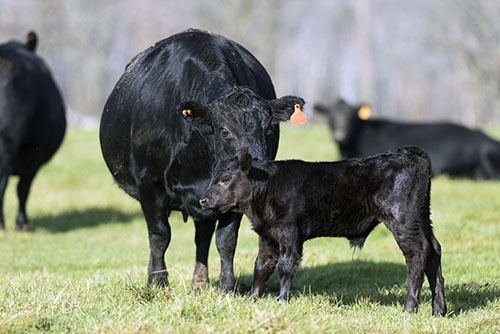Spring Cattle Vaccinations
May 17, 2021

Spring is a good time to gather cows and calves for vaccinations and de-worming. But often producers ask the age-old question – what do I vaccinate against?
There are certain diseases, that should be considered of economic importance. Cattle should receive a vaccination for Infectious Bovine Rhinotracheitis (IBR), Bovine Virus Diarrhea (BVD), Parainfluenza-3 Viral Infection (PI3), and Bovine Respiratory Syncytial Virus (BRSV). Each of these diseases have different effects on the cattle.
IBR (Infectious Bovine Rhinotracheitis) – This virus is also known as Red Nose. Animals have high temperatures (108 degrees), large amounts of nasal discharge, coughing, lesions in the mouth or nostrils, and increased respiration. Their muzzles may be reddened or encrusted. In many cases, the disease will affect the eyes as well, with affected animals exhibiting runny eyes, which can often be confused with pinkeye. Abortions are also possible.
BVD (Bovine Virus Diarrhea) – Symptoms include high temperatures, nasal discharge,
poor or no appetite, and respiratory problems. This disease affects the digestive and respiratory tracts. Sometimes watery, light brown, or yellowish diarrhea will be noticed, but not in all cases. In some instances, bits of intestinal wall or tissue are found in the feces. Some cases are mild and go un-noticed. Many times, cows and calves are noted for having a weak immune system because BVD is immunosuppressive and can interfere with the normal function of the immune system.
PI3 (Parainfluenza-3 Viral Infection) – Commonly known as the bovine flu, but usually causes little damage in itself. However, the infection predisposes the animal or opens the door for secondary bacterial infections such as pneumonia. PI3 symptoms are similar to other viral respiratory diseases with symptoms of runny eyes, nasal discharge, lung congestion, coughing, or dehydration, and muscle trembling.
BRSV (Bovine Respiratory Syncytial Virus) – Symptoms include high temperatures (104-108 degrees). Initial exposures to younger animals seem to be most severe. Older animal exposure usually results in milder cases. Depression, decrease in feed consumption, increased respiratory rate, cough, and nasal discharge are often seen. Secondary bacterial infections, like pneumonia or Pasteurella, often follow this virus infection.
With the potential for harm these diseases pose, it is wise to take these simple steps to decrease your herd’s likelihood of infection. Cattle can be immunized against these diseases very easily by using any number of vaccine combinations. Options for both killed and modified-live vaccine combinations are available at your local Co-op. For more information about these vaccines, see your local Co-op beef specialist.
For more content like it, read the latest issue of the Cooperator.
There are certain diseases, that should be considered of economic importance. Cattle should receive a vaccination for Infectious Bovine Rhinotracheitis (IBR), Bovine Virus Diarrhea (BVD), Parainfluenza-3 Viral Infection (PI3), and Bovine Respiratory Syncytial Virus (BRSV). Each of these diseases have different effects on the cattle.
IBR (Infectious Bovine Rhinotracheitis) – This virus is also known as Red Nose. Animals have high temperatures (108 degrees), large amounts of nasal discharge, coughing, lesions in the mouth or nostrils, and increased respiration. Their muzzles may be reddened or encrusted. In many cases, the disease will affect the eyes as well, with affected animals exhibiting runny eyes, which can often be confused with pinkeye. Abortions are also possible.
BVD (Bovine Virus Diarrhea) – Symptoms include high temperatures, nasal discharge,
poor or no appetite, and respiratory problems. This disease affects the digestive and respiratory tracts. Sometimes watery, light brown, or yellowish diarrhea will be noticed, but not in all cases. In some instances, bits of intestinal wall or tissue are found in the feces. Some cases are mild and go un-noticed. Many times, cows and calves are noted for having a weak immune system because BVD is immunosuppressive and can interfere with the normal function of the immune system.
PI3 (Parainfluenza-3 Viral Infection) – Commonly known as the bovine flu, but usually causes little damage in itself. However, the infection predisposes the animal or opens the door for secondary bacterial infections such as pneumonia. PI3 symptoms are similar to other viral respiratory diseases with symptoms of runny eyes, nasal discharge, lung congestion, coughing, or dehydration, and muscle trembling.
BRSV (Bovine Respiratory Syncytial Virus) – Symptoms include high temperatures (104-108 degrees). Initial exposures to younger animals seem to be most severe. Older animal exposure usually results in milder cases. Depression, decrease in feed consumption, increased respiratory rate, cough, and nasal discharge are often seen. Secondary bacterial infections, like pneumonia or Pasteurella, often follow this virus infection.
With the potential for harm these diseases pose, it is wise to take these simple steps to decrease your herd’s likelihood of infection. Cattle can be immunized against these diseases very easily by using any number of vaccine combinations. Options for both killed and modified-live vaccine combinations are available at your local Co-op. For more information about these vaccines, see your local Co-op beef specialist.
For more content like it, read the latest issue of the Cooperator.